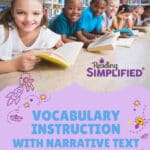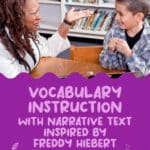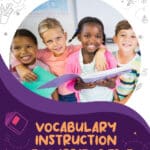
Many of our children come to us with limited vocabulary knowledge, so we want to provide vocabulary instruction in as much of the English language - oral or written form - as possible. Yet, it's tricky--we have limited time and there are so many words....
The Oxford English Dictionary has around 600,000 words forms (with around 171,476 of them being in use today). That’s a lot of words! You can’t possibly provide vocabulary instruction for every single word in the English language, right? That would take forever! So, which ones should you teach?
I recently talked to Dr. Elfrieda Hiebert, Ph.D., University of Wisconsin, and the author of Teaching Words and How They Work about this exact topic. We talked about some of the innovative ideas she presented in her book for vocabulary instruction. (You can watch my video interview with Freddy or read the transcript/blog post here).
I’ve been so inspired by Freddy’s work; I want to unpack some of the key concepts from her book. Let's focus on her "Small Changes That Can Make Big Vocabulary Results” idea, and dig deeper here into vocabulary instruction with narrative texts. Try these concrete examples to help you get started with some of Freddy’s ideas as soon as tomorrow!
Sound good? I thought so!Small Changes That Can Make Big Vocabulary Results
[If you'd rather read the transcript from the above video on vocabulary instruction, here ya go...]
Vocabulary Instruction with Narrative Texts
We're going to be talking about narrative texts for vocabulary instruction--how you can associate the texts that you're already reading, or that you want to add to your repertoire, and how you would associate that particular vocabulary with that.
If you have to learn 50,000 words by 12th grade, how is that possible?
We know a lot of typically developing third graders may know about 10,000 words. So, between third grade and 12th grade, they've got to learn about three to 4,000 words a year, which comes out to - if you divide by 180 school days - about 16 to 17 words a day!
Who can teach their students 16 words a day? That's intimidating, right? But don't worry, it's not all up to you.
Another estimate is that students need to read a thousand words to be able to learn one new vocabulary word. So if you think about a typical typewritten page, it's about 250 words, (double-spaced typical typewritten page, like the pages you wrote for in college). So that would mean you have to read four of those pages to learn one word.
That’s a lot of reading. Does anyone's curriculum call for 16 words a day? This doesn't sound realistic, does it? But don’t worry, we're going to address some ways in which it might be possible....Variation in the Amount of Independent Reading of Words
So, another really important stat is this graph below:

This is a very well-known study. I think it was fourth and fifth graders and how much time they spent reading. The kids in the upper end of the graph, (98th percentile) read almost 5 million words a year. Look at what the kids at the 50th percentile read, they read a little bit more than 500,000.
So, if you think about that, how many words you have to read to be able to learn vocabulary, Who is going to be out in the lead? It's our big readers, right? We have to get our kids reading rapidly.
Even at the 90th percentile the kids who are really reading a lot, but not like the 98th percentile in terms of volume read, they're only consuming a little bit more than 2 million words.
So, the volume of reading is a big deal for learning vocabulary knowledge, and the more we can do to inspire kids to read more, the better off we are.
If this is the norm, anything you do to move your kids up to 90% and below, another 20,000, another hundred thousand, or 1 million words in a year, you're making a big change. You're shifting this graph a lot. And so, before we get into vocabulary strategies, I just want to remind you that's one of the main reasons that I have done the work of Reading Simplified.
Finding a really streamlined way to get kids rapidly able to read words, so that they can read widely and early on, be successful, feel happy about themselves, and read more. When we have success at something, we tend to do the thing that we're good at. So we've created an approach that streamlines the approach to teaching word recognition here at Reading Simplified.
Word recognition is one of the biggest levers that you can give kids is giving them quick access to the code.
3 Big Levers for Vocabulary Instruction
One of the really exciting concepts that Dr. Hiebert came out with is that 90% of the words that kids need to know when they're in high school, can be reduced to about 2,500 word families. A word family is just a collection of words that have a lot of similarities.

For example, she used the example of "glory," "glorious," "inglorious." Anything related to that one word would be a family that's tied to glory. She's saying let's be strategic about making sure we're getting to the 2,500 word families.
What are the ways that we can do this? We've talked about this before at Reading Simplified - What are the big rocks?
Well, with vocabulary reading knowledge, there are 3 big levers:
1. Oral language
2. Written language
3. Students’ working with words
The more we hear sophisticated language and use it orally, the more words we will learn.How to Achieve BIG Vocabulary Results with Narrative Texts
Let's think about our language as teachers, using high level words, elaborating on those words and defining them, asking the students to do the same, and then also giving them exposure to lots of written language so that they can more rapidly learn more and more words.
So, what is Dr. Freddy's big revolution?
She says, let's overturn this mainstream approach to vocabulary instruction. If you have seen a reading program, like a reading series or a basal reading program that suggests that you read a narrative text, and then you focus on the five to six words that are probably unknown to the student that are tied to that book. Well, often these words are just picked because they're challenging and they don't relate to the theme of the book and they don't relate to one another. Teaching kids’ isolated words over and over again is unmanageable.
Dr. Freddy’s big idea is to change from that traditional vocabulary instruction approach to a network approach. When you show children the relationships of words, it's a lot easier for kids to learn a lot more words.
Don't pick words randomly. We pick them strategically based on how we can build and expand, connected ideas. That's how our brain works. Neurons make connections across different parts of the brain. Thus, the more exposures we have to different ideas that are related, the stronger the depth of knowledge on a particular concept or in this case, "words."
‘The Network Approach’ in Action!
Here is a list of words to look at from the book, Annie’s Gifts, that Dr. Hiebert includes in her book Teaching Words and How They Work.

Do you see any connection among the words? Do they relate to the theme of the book?
Well, if you haven't read the book, you might not know, but it's about a girl who is listening to her siblings demonstrate their talent with musical instruments. She feels frustrated when she tries various instruments and can't do it and then finally, she finds her gift, not something she receives, but some natural talents that she has.
So, does "except," or "stomped," or "entertain," relate to that? No. This is a list of words that are unrelated. Of course, "entertain," might be something more thematic.
So, what are we going to do instead of having a random list of words?
The answer is to build a network!
We can make connections among those words. Here’s an example of connected words that are in a network. It’s taken from Freddy’s book that shows a semantic map of target words from the narrative text, Annie’s Gifts:
There are so many that you can do with a given book, but she puts music at the center. One category on your left is music events, the words, "performance," "lesson," "entertain," "entertainment," the word "program," and "delivered." Those are all things related to music events that may or may not have been in the book.
The idea for vocabulary instruction in narrative texts is not that you have to stick tightly to the words in the book; it's that some of the concepts in the book and some of the words in the book can be built on and connected, and then built on and expanded. Another one is she's got this list of "instruments," the "recorder," "trumpet," "cello," the "bass," "brass," and a "mahogany piano." And on the right, sounds when Annie plays, "screeching," "croaking," "squawk," "squeak," "like a diesel truck honking."
At the bottom (in the center), parts of music, there's the word, "melody," and "rhythm," and "chorus," and "notes," So, you see how the teacher can help the students draw out words from the text, elaborate them, and define them?
“So, how is, "screeching" different than "croaking"? We often use "screeching" in connection with an "owl." So, you have my permission class. You can try to "screech". Who knows what a "screech" is? But don't get too loud. And what animal is often used when we think about a "croak"? What sound is that? How is that different than "screeching"?”
You can talk about the words, but you're connecting it with sounds when any play, and maybe you build in other words that may or may not have been in the book. You're building connections among words by categories.
This is the network approach. I'm hoping this is just one example of a freeing way which you can take something that's already existing. If you are even mandated to teach these words, you can expand on those very words with your students in a very playful way through conversations, to make it fun.
Hopefully this will help you to get started!
How to Accomplish These Vocabulary Instructional Ideas WITHOUT Being Overwhelmed
I know what you’re thinking – how can I accomplish all of this without being overwhelmed? Am I right? Well, that's our job here at Reading Simplified - to streamline what can be overwhelming otherwise.
If we have some issues with our reading approaches and we're going to tweak it, let's make something doable out of it. We're talking about how to streamline vocabulary instruction for narrative texts. First of all, I just want to refer you to a bookmark that is kind of cool (if I do say so myself).
This is a teacher bookmark and includes some core routines that I would use for teaching vocabulary and a lot of it involves making sure you're doing multi-sensory instruction. The words that you're teaching are not just orally provided, but really show the kids what it looks like on the dry erase board.
Tying sounds and symbols will help build their orthographic mapping. This is going to turn words like “performance” into a sight word. This is going to be part of what's needed and it's building in another mental hook.
It's not just the auditory, it's not just the visual, but it's also kinesthetic. You can even dive deeper if you have time, for example: “I noticed there's the /er/ sound there and the, /or/ sound there. And that funny /s/, at the end, everybody say it with me "performance."
That way, it doesn't take much time, but you're tying in that multi-sensory system, those cues to help these words get learned. This ties into everything that we're already doing at Reading Simplified, streamlining how to get connect sounds and symbols.
You can grab your FREE “Vision for a Voluminous Vocabulary” bookmark here!3 Instructional Techniques to Build Vocabulary Networks!
If you go to textproject.org, there's so much there that you might get lost! So, I'm going to give you some really clear guidelines about how to make vocabulary instruction easier for your day to day planning and to tie it in with what you're already mandated to do if you have a curriculum that's outside of your control.
So, here are my top three ideas to help you make the most out of Freddy’s resources at TextProject and teach kids more words using the network approach:

What I love about textproject.org is that Dr. Freddy draws our attention to new and unique characteristics of words. So, let's dive into those three ways in which you can take the idea of networks and not overwhelm yourself.
1. Build networks with “required words”
In other words, if you have words that are already mandated from your basal or from some other source, and they're not already in some sort of network, try to find a way to build a network yourself. I did this in 30 seconds and here’s how…
I took the word "carefree" (from Annie’s Gift) and thought about the things I could add to make it more in-depth. I added similar words in the network of "carefree" such as "idle", "unworried", "easy-going", and so on. Here’s an example of what this process looked like:

The idea is to take the words you already have, idea number one, and then build your own network. It can be casual, it does not have to be a dissertation! It can be done quickly and it can be done with the student’s support. Put this work up on the wall and talk about it across the week.
2. Build networks of words important to the book's theme
Annie’s Gift is about a girl who is a little jealous or sad that she didn't have what her siblings had and it revolved around music. So, Freddy created music at the hub and created these different categories relating to music such as how music makes people move and feel.
As you can see, the word "sway" got in there. I think that was tied into "stomped". So, "stomped" was the category of how music makes people feel "stomp", but then some other words are in there, "sway", "tap", "dance", "clap", "finger popping", "carefree", "soulful". So, it's one little category that's tied into music, somewhat tangentially, and that the network is being built on the theme or one concept that's in the book.
You can do this yourself and have fun building it with your students. You can also rely on some resources at TextProject.
3. Build networks related to significant emotion/action in story
My third idea is to build networks related to a significant emotion or action in the story, and then tie it to Freddy's resources at textproject.org.
So, let me show you a few of her amazing resources that I highly recommend:

This is an example from TextProject’s Super Synonym Sets for Stories. She picked out words that are pretty ubiquitous. Basically, you take a simple concept word then you blow it up.
One of the things that Annie wanted was skills that she didn't have. She wanted what her siblings had. So here's an example from Exceptional Expressions For Everyday Events that you could take and pair it with this book, potentially.
And the one category says "Want", as in, to have a longing for. To "pine," to "yearn," to "long," to "covet," to "desire," to "wish," to "crave." Of course you would define them and you would elaborate on them with words and get the students to do the same.
You can then tie it to multi-sensory cues. I'm going to, "crave" chocolate all my life. Another category is, "Want" as in to need something, to "demand," to "require," to "need." She's got the common phrases like "wanted man," "what more do you want," "gotta," or "gotta have it," or "have to have it," "I want in or out," "just where you want them," "to your heart's desire."
So, it's doesn't even have the word "want" in it, but it's a phrase that's connected to want, "want for nothing," "all I want," "free from want," an idiom would be "waste not, want not."
You don't even have to do the prep. She's done all the prep for you, and then there's more!
She’s also got the morphology:
On the left side, you’ll see the inflected endings for the morphological family for "Want." I "want," she "wants," we "wanted," we are still "wanting" to get the cafeteria food to be tastier. In the center, she's got derivational prefixes and suffixes, like "unwanted." And then the compound words, or maybe in this case, it's more like a phrase, like a "wanted ad."
This is repeated over and over again with the exceptional expressions. Similarly, with a super synonym, I picked out the word "start", like she was going to "start" a new habit, "start" discovering a new talent that she had.

To "start", as in the place or times something "begins.” Some common phrases like to "start with," idioms like "to start," or "get the ball rolling." Again, the Spanish connection to "start," as in, to "leave," or "depart," or "to get it off the ground," to "commence," to "start up," to "embark on." They're all connected.
Would this be easier for kids to learn these words when they're connected that way? Now, does this mean that by the end of the week, they'll know all of these words, maybe not, but will they know more than six to eight? That's kind of the question. That's this revolution that we were excited to hear Freddy talk about and what she's teaching about in this book, Teaching Words and How They Work: Small Changes for Big Vocabulary Results.
These ideas are just the tip of the iceberg in her book, so I encourage you to get a copy! (The link above will take you to it and Reading Simplified may receive small compensation via Amazon.)
Take a Simplified Approach for Building A Vocabulary Networks In Narrative Texts
So, those are my top three tips for enhancing your vocabulary instruction of narrative texts via a network approach.
I know, you're being asked to teach too much, but what I've been trying to teach here at Reading Simplified, is that the main thing you have to do is get kids to rapidly learn how to read words so that they can then read a lot. And through reading a lot, they're more likely to have the vocabulary that they need to be able to understand everything.
This is what we do here at Reading Simplified, we teach you a streamlined approach for getting anyone up to grade level in reading rapidly so they can love reading and read widely. But there's another big part of being a good reader, being a good student, and that's learning the meanings of words.
Dr. Freddy has shown us that if we think about words in terms of word families and try to create networks among them, instead of the hit or miss five to six words randomly picked from a book, we'll probably have a bigger impact.
Starting small is smart so that you don't get overwhelmed!
Want to discover how to accelerate all of your readers... in a simplified way that saves you time?
The Reading Simplified Academy uses a streamlined system for teaching anyone how to read FAST. Join the Reading Simplified Academy so you can learn how to streamline your teaching of reading and help struggling readers leap ahead!
What are your thoughts on Dr. Freddy’s ‘network approach’? Are you going to try this with your own students? Let me know in the comments!






